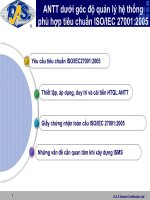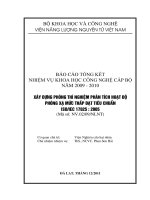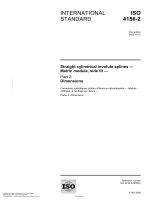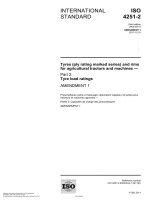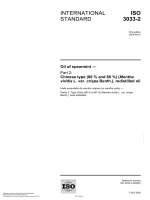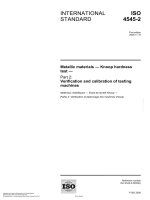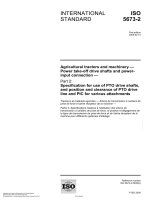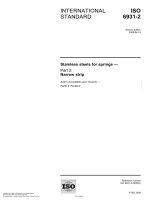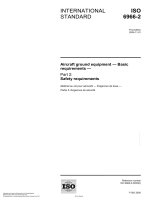Tiêu chuẩn iso 01920 2 2005
Bạn đang xem bản rút gọn của tài liệu. Xem và tải ngay bản đầy đủ của tài liệu tại đây (437.35 KB, 64 trang )
INTERNATIONAL
STANDARD
ISO
1920-2
First edition
2005-04-15
Testing of concrete —
Part 2:
Properties of fresh concrete
Essais du béton —
Partie 2: Caractéristiques du béton frais
Reference number
ISO 1920-2:2005(E)
--`,,`,,,-`-`,,`,,`,`,,`---
Copyright International Organization for Standardization
Reproduced by IHS under license with ISO
No reproduction or networking permitted without license from IHS
Not for Resale
© ISO 2005
ISO 1920-2:2005(E)
PDF disclaimer
This PDF file may contain embedded typefaces. In accordance with Adobe's licensing policy, this file may be printed or viewed but
shall not be edited unless the typefaces which are embedded are licensed to and installed on the computer performing the editing. In
downloading this file, parties accept therein the responsibility of not infringing Adobe's licensing policy. The ISO Central Secretariat
accepts no liability in this area.
Adobe is a trademark of Adobe Systems Incorporated.
Details of the software products used to create this PDF file can be found in the General Info relative to the file; the PDF-creation
parameters were optimized for printing. Every care has been taken to ensure that the file is suitable for use by ISO member bodies. In
the unlikely event that a problem relating to it is found, please inform the Central Secretariat at the address given below.
© ISO 2005
All rights reserved. Unless otherwise specified, no part of this publication may be reproduced or utilized in any form or by any means,
electronic or mechanical, including photocopying and microfilm, without permission in writing from either ISO at the address below or
ISO's member body in the country of the requester.
--`,,`,,,-`-`,,`,,`,`,,`---
ISO copyright office
Case postale 56 • CH-1211 Geneva 20
Tel. + 41 22 749 01 11
Fax + 41 22 749 09 47
Web www.iso.org
Published in Switzerland
ii
Copyright International Organization for Standardization
Reproduced by IHS under license with ISO
No reproduction or networking permitted without license from IHS
© ISO 2005 – All rights reserved
Not for Resale
ISO 1920-2:2005(E)
Contents
Page
Foreword ............................................................................................................................................................ iv
Introduction ........................................................................................................................................................ v
Scope...................................................................................................................................................... 1
2
Normative references ........................................................................................................................... 1
3
Terms and definitions........................................................................................................................... 1
4
4.1
4.2
4.3
4.4
4.5
4.6
4.7
Determination of consistence.............................................................................................................. 2
General ................................................................................................................................................... 2
Sampling ................................................................................................................................................ 2
Slump test .............................................................................................................................................. 2
Vebe test ................................................................................................................................................ 5
Degree of compactability test .............................................................................................................. 8
Flow-table test ..................................................................................................................................... 11
Slump-flow test ................................................................................................................................... 15
5
5.1
5.2
5.3
5.4
5.5
5.6
Determination of fresh density .......................................................................................................... 18
Principle ............................................................................................................................................... 18
Apparatus............................................................................................................................................. 18
Sampling .............................................................................................................................................. 19
Procedure............................................................................................................................................. 19
Test result ............................................................................................................................................ 20
Test report............................................................................................................................................ 20
6
6.1
6.2
6.3
6.4
6.5
6.6
6.7
Determination of air content .............................................................................................................. 21
General ................................................................................................................................................. 21
Sampling .............................................................................................................................................. 21
Filling the container and compacting the concrete......................................................................... 21
Pressure-gauge method ..................................................................................................................... 22
Water-column method ........................................................................................................................ 24
Calculations and expression of results ............................................................................................ 27
Test report............................................................................................................................................ 27
7
Test report............................................................................................................................................ 28
--`,,`,,,-`-`,,`,,`,`,,`---
1
Annex A (informative) Precision — Data for the density measurements ................................................... 29
Annex B (normative) Calibration of the container for the density test ....................................................... 30
Annex C (informative) Additional calculations for the density test............................................................. 31
Annex D (informative) Precision — Water-column method ......................................................................... 32
Annex E (normative) Calibration of apparatus — Pressure-gauge method ............................................... 33
Annex F (normative) Calibration of apparatus — Water-column method .................................................. 35
Annex G (normative) Aggregate corrector factor — Pressure-gauge method .......................................... 38
Annex H (normative) Aggregate correction factor — Water-column method............................................ 40
Annex I (informative) Examples of test reports and worksheets................................................................. 42
Bibliography ..................................................................................................................................................... 56
iii
© ISO 2005 – All rights reserved
Copyright International Organization for Standardization
Reproduced by IHS under license with ISO
No reproduction or networking permitted without license from IHS
Not for Resale
ISO 1920-2:2005(E)
--`,,`,,,-`-`,,`,,`,`,,`---
Foreword
ISO (the International Organization for Standardization) is a worldwide federation of national standards bodies
(ISO member bodies). The work of preparing International Standards is normally carried out through ISO
technical committees. Each member body interested in a subject for which a technical committee has been
established has the right to be represented on that committee. International organizations, governmental and
non-governmental, in liaison with ISO, also take part in the work. ISO collaborates closely with the
International Electrotechnical Commission (IEC) on all matters of electrotechnical standardization.
International Standards are drafted in accordance with the rules given in the ISO/IEC Directives, Part 2.
The main task of technical committees is to prepare International Standards. Draft International Standards
adopted by the technical committees are circulated to the member bodies for voting. Publication as an
International Standard requires approval by at least 75 % of the member bodies casting a vote.
Attention is drawn to the possibility that some of the elements of this document may be the subject of patent
rights. ISO shall not be held responsible for identifying any or all such patent rights.
ISO 1920-2 was prepared by Technical Committee ISO/TC 71, Concrete, reinforced concrete and prestressed concrete, Subcommittee SC 1, Test methods for concrete.
This first edition of ISO 1920-2 cancels and replaces the first edition of ISO 4109:1980, ISO 4110:1979,
ISO 4111:1979, ISO 4848:1980 and ISO 6276:1982, which have been technically revised.
ISO 1920 consists of the following parts, under the general title Testing of concrete:
Part 1: Sampling of fresh concrete
Part 2: Properties of fresh concrete
Part 3: Making and curing of test specimens
Part 4: Strength of hardened concrete
Part 5: Properties of hardened concrete other than strength
Part 6: Sampling, preparing and testing of concrete cores
Part 7: Non-destructive tests on hardened concrete
iv
Copyright International Organization for Standardization
Reproduced by IHS under license with ISO
No reproduction or networking permitted without license from IHS
© ISO 2005 – All rights reserved
Not for Resale
ISO 1920-2:2005(E)
Introduction
International Standards are widely adopted at the regional or national level and applied by manufacturers,
trade organizations, purchasers, consumers, testing laboratories, authorities and other interested parties.
Since these standards generally reflect the best experience of industry, researchers, consumers and
regulators worldwide and cover common needs in a variety of countries, they constitute one of the important
bases for the removal of technical barriers to trade. However, full adoption may not be practicable in all cases
for reasons such as regional or national security, protection of human health or safety, or protection of the
environment, or because of fundamental climatic, geographical or technological problems. As a consequence,
the corresponding technical deviations to ISO standards are permitted where required by national or regional
legislation or industry convention when adopting an International Standard.
Where such national deviations are required, it is important that they are clearly identified and the reasons for
the deviations stated. Depending of on the method of adoption of the International Standard, the deviations
will be noted in the national introduction, in the preface or foreword (for small numbers) or as a national annex
(for large numbers). See ISO/IEC Guide 21-1 for more information.
ISO/TC 71 has identified those items in this part of ISO 1920-2 that may be the subject of national or regional
deviations. The items are indicated in the text by the phrase “…except where the national annex to this part of
ISO 1920 requires…”.
--`,,`,,,-`-`,,`,,`,`,,`---
v
© ISO 2005 – All rights reserved
Copyright International Organization for Standardization
Reproduced by IHS under license with ISO
No reproduction or networking permitted without license from IHS
Not for Resale
--`,,`,,,-`-`,,`,,`,`,,`---
Copyright International Organization for Standardization
Reproduced by IHS under license with ISO
No reproduction or networking permitted without license from IHS
Not for Resale
INTERNATIONAL STANDARD
ISO 1920-2:2005(E)
Testing of concrete —
Part 2:
Properties of fresh concrete
Caution — When cement is mixed with water, alkali is released. When sampling, prevent skin contact
with wet cement or concrete by wearing suitable protective clothing (gloves, footwear, safety glasses).
If wet cement or concrete enters the eye, immediately wash it out thoroughly with clean water and
seek medical treatment without delay. Wash wet concrete off the skin immediately.
Caution — The use of vibrating equipment, such as vibration tables, can cause damage to joints and
loss of sensation due to nerve damage. Moulds, density containers, etc. should be clamped to the
table and not held in position using one's hands while they are being vibrated.
1
Scope
This part of ISO 1920 specifies procedures for testing fresh concrete. It specifies the following test methods:
determination of consistence (slump test, Vebe test, degree of compactability, flow-table test and for
high-fluidity concrete, the slump-flow test), determination of fresh density and determination of air content by
the pressure-gauge method and by the water-column method.
2
Normative references
The following referenced documents are indispensable for the application of this document. For dated
references, only the edition cited applies. For undated references, the latest edition of the referenced
document (including any amendments) applies.
--`,,`,,,-`-`,,`,,`,`,,`---
ISO 1101:1983, Technical drawing — Geometric tolerances — Tolerancing of form, orientation, location and
run-out — Generalities, definitions, symbols, indications on drawings
ISO 1920-1, Testing of concrete Part 1: Sampling of fresh concrete
3
Terms and definitions
For the purposes of this document, the following terms and definitions apply.
3.1
fresh density
mass of a quantity of fully compacted fresh concrete divided by its volume
NOTE
The fresh density is expressed in kilograms per cubic metre.
1
© ISO 2005 – All rights reserved
Copyright International Organization for Standardization
Reproduced by IHS under license with ISO
No reproduction or networking permitted without license from IHS
Not for Resale
ISO 1920-2:2005(E)
4
Determination of consistence
4.1
General
The consistence of the concrete is determined by one of the methods described below:
slump test (see 4.3);
Vebe test (see 4.4);
degree of compactability (see 4.5);
flow-table test. (see 4.6);
slump-flow test for high-fluidity concrete (see 4.7).
These methods are not applicable to foamed concrete, no-fines concrete or where the maximum aggregate
size exceeds 40 mm.
4.2
Sampling
Samples for the tests shall be obtained in accordance with ISO 1920-1. Each sample shall be remixed before
carrying out the tests.
4.3
Slump test
4.3.1
Principle
The fresh concrete is compacted into a mould in the shape of a frustum of a cone. When the cone is
withdrawn upwards, the distance the concrete has slumped provides a measure of the consistence of the
concrete.
The slump test is applicable to a range of consistence of concrete that corresponds to slumps of between
10 mm and 210 mm. Outside this range, the measurement of slump may be unsuitable and other methods of
determining the consistence should be considered.
If the slump continues to change over a period of 1 min after demoulding, this test is not suitable.
NOTE
4.3.2
For high-fluidity concrete, the slump-flow test described in 4.7 is a more appropriate test.
Apparatus
Note the calibration requirements associated with each apparatus.
4.3.2.1
Mould, suitable of forming the test specimen, made of a metal not readily attacked by cement
paste and not thinner than 1,5 mm.
The mould may be made either with or without a seam. The interior of the mould shall be smooth and free
from projections such as protruding rivets and shall be free from dents. The mould shall be in the form of
hollow frustum of a cone and shall have the following internal dimensions:
diameter of base:
200 mm ± 2 mm;
diameter of top:
100 mm ± 2 mm;
height:
300 mm ± 2 mm.
2
Copyright International Organization for Standardization
Reproduced by IHS under license with ISO
No reproduction or networking permitted without license from IHS
--`,,`,,,-`-`,,`,,`,`,,`---
© ISO 2005 – All rights reserved
Not for Resale
ISO 1920-2:2005(E)
The base and the top shall be open and parallel to each other and at right angles to the axis of the cone. The
mould shall be provided, on the upper portion, with two handles at two-thirds of the height, and at the bottom
with fixing clamps or foot pieces to hold it steady. A mould that can be clamped to the base is acceptable,
provided the clamping arrangement can be fully released without movement of the mould or interference with
the slumping concrete.
The mould shall be visually checked prior to each use to assure that it is clean and is not damaged or dented.
The cone shall be checked annually to ensure that its dimensions and conditions remain within tolerances.
4.3.2.2
Tamping rod, straight, made of steel, having a circular cross-section with a diameter of
16 mm ± 1 mm, 600 mm ± 5 mm in length, and with rounded ends. The rod may be extended with a handle of
plastic conduit, provided that the overall length does not exceed 1 000 mm.
The tamping rod shall be checked annually to ensure that its dimensions and conditions remain within
tolerances.
4.3.2.3
Funnel (optional), made of a non-absorbent material not readily attacked by cement paste.
The funnel shall consist of two co-axial conical frustums having a common diameter of 100 mm, the ends
being of greater diameter, one frustum to act as a filling funnel and the other as a collar to enable the funnel to
be located on the outer surface of the mould.
The funnel shall be checked annually to ensure that its dimensions and conditions remain within tolerances.
--`,,`,,,-`-`,,`,,`,`,,`---
4.3.2.4
Rule, graduated from 0 mm to 300 mm, at intervals not exceeding 5 mm, with the zero point
being at the extreme end of the rule.
4.3.2.5
Base plate/surface, rigid, flat, non-absorbent and smooth plate or other surface on which to
place the mould.
4.3.2.6
Shovel, with a square blade.
4.3.2.7
Re-mixing tray, of rigid construction and made from a non-absorbent material not readily
attacked by cement paste.
It shall be of appropriate dimensions such that the concrete can be thoroughly remixed, using the squarebladed shovel.
4.3.2.8
Scoop, with a width of approximately 100 mm.
4.3.2.9
Timer or other similar timing device, to allow time measurement to 1 s.
The watch shall be properly calibrated at the time of test.
4.3.2.10
4.3.3
Moist cloth.
Procedure
Dampen the mould and the base plate. Wipe any excessive water from the surfaces, using an absorbent
cloth. Place the mould on the horizontal base plate/surface. During filling, clamp or hold the mould firmly in
place by standing on the two foot pieces.
Immediately after obtaining the sample in accordance with 4.2, fill the mould in three layers, each
approximately one-third of the height of the mould when compacted. When adding the concrete, ensure that it
is distributed symmetrically around the mould. Tamp each layer with 25 strokes of the tamping rod. Uniformly
distribute the strokes over the cross-section of each layer. For the bottom layer, this will necessitate inclining
the rod slightly and positioning approximately half the strokes spirally toward the centre. Tamp the second
layer and the top layer each throughout its depth, so that the strokes just penetrate into the underlying layer.
In filling and tamping the top layer, heap the concrete above the mould before tamping is started.
3
© ISO 2005 – All rights reserved
Copyright International Organization for Standardization
Reproduced by IHS under license with ISO
No reproduction or networking permitted without license from IHS
Not for Resale
ISO 1920-2:2005(E)
If the tamping operation of the top layer results in subsidence of the concrete below the top edge of the mould,
add more concrete to keep an excess above the top of the mould at all times. Also ensure that the addition of
concrete to the top layer does not provide extra compaction of the concrete. After the top layer has been
tamped, scrape off the surface of the concrete level with the top of the mould by means of a sawing and rolling
motion of the tamping rod.
Remove spilled concrete from the base plate/surface. Remove the mould in 5 ± 2 s by a steady upward lift
with no lateral or torsional motion being imparted to the concrete. The lifting time may be shortened when
required by the national annex.
The entire operation from the start of the filling to the removal of the mould shall be carried out without
interruption and shall be completed within 180 s.
Immediately after removal of the mould, determine the slump, h, by measuring the difference between the
height of the mould and that of the highest point of the slumped test sample (see Figure 1), except where the
national annex to this part of ISO 1920 requires the measurement of the difference between the height of the
mould and the centre point or the average height of the slumped concrete. Measure to the nearest 10 mm,
except where the national annex to this part of ISO 1920 requires the measurement to the nearest 5 mm.
Test result
The test is valid only if it yields a true slump, this being a slump in which the concrete remains substantially
intact and symmetrical as shown in Figure 2 a). If a specimen shears, as shown in Figure 2 b), take another
sample and repeat the procedure.
Record the true slump, h, as shown in Figure 1 to the nearest 10 mm, or 5 mm when required by the national
annex.
If two consecutive tests show a portion of the concrete shearing off from the mass of the test specimen, report
the test as being invalid as the concrete lacks the necessary plasticity and cohesiveness for the slump test to
be suitable.
Figure 1 — Slump measurement
a) True slump b) Shear
Figure 2 — Forms of slump
4
Copyright International Organization for Standardization
Reproduced by IHS under license with ISO
No reproduction or networking permitted without license from IHS
© ISO 2005 – All rights reserved
Not for Resale
--`,,`,,,-`-`,,`,,`,`,,`---
4.3.4
ISO 1920-2:2005(E)
4.3.5
Test report
In addition to the information required in Clause 7, the test report shall include the following:
a)
the slump, if there is a true slump, measured to nearest 10 mm (or 5 mm when required by the national
annex), or;
b)
a notation that the test gave a sheared slump.
4.4
Vebe test
4.4.1
Principle
The fresh concrete is compacted into a slump mould. The mould is lifted clear of the concrete and a
transparent disc is swung over the top of the concrete and carefully lowered until it comes in contact with the
concrete. The slump of the concrete is recorded. The vibrating table is started and the time taken for the lower
surface of the transparent disc to be fully in contact with concrete is measured.
If the Vebe time is less than 5 s or more than 30 s, the use of this test method to determine consistence may
be unsuitable and other methods should be considered for this purpose.
4.4.2
Apparatus
Note the calibration requirements associated with each apparatus.
4.4.2.1
a)
Consistometer (Vebe meter), consisting of the following items and as shown in Figure 3:
container (Figure 3, item 1), cylindrical in shape, having an internal diameter of 240 mm ± 5 mm and a
height of 200 mm ± 2 mm, and made of a metal not readily attacked by cement paste. The thickness of
the wall shall be 3 mm and that of the base, 7,5 mm.
The container shall be watertight and of sufficient rigidity to retain its shape under rough usage. It shall be
fitted with handles and protected from corrosion. The container shall be provided with suitable foot pieces
to enable it to be securely clamped to the top of the vibrating table (Figure 3, item 7) by means of wing
nuts (Figure 3, item 8).
b)
mould (Figure 3, item 2), as described in 4.3.2.1, except that the fixing clamps or foot pieces are not
required.
The mould shall be visually checked prior to each use to assure that it is clean and is not damaged or
dented.
c)
disc (Figure 3, item 3), transparent, horizontal, attached to a rod (Figure 3, item 9) that slides vertically
through a guide sleeve (Figure 3, item 5) mounted on a swivel arm (Figure 3, item 13) and which can be
fixed in position by a screw (Figure 3, item 15).
The swivel arm also supports a funnel (Figure 3, item 4), the bottom of which coincides with the top of the
conical mould when the latter is positioned concentrically in the container. The swivel arm is located by a
holder (Figure 3, item 12) and can be fixed in position by a set-screw (Figure 3, item 6). When in the
appropriate position, the axes of the rod and of the funnel shall be coincident with the axis of the
container.
The transparent disc shall be 230 mm ± 2 mm in diameter and 10 mm ± 2 mm in thickness. A weight
(Figure 3, item 14) placed directly above the disc shall be provided such that the moving assembly
consisting of the rod, the disc and the weight has a mass of 2 750g ± 50 g. The rod shall be provided with
a scale graduated to at least 5 mm intervals to record the slump of the concrete.
--`,,`,,,-`-`,,`,,`,`,,`---
5
© ISO 2005 – All rights reserved
Copyright International Organization for Standardization
Reproduced by IHS under license with ISO
No reproduction or networking permitted without license from IHS
Not for Resale
ISO 1920-2:2005(E)
d)
vibrating table (Figure 3, item 7), 380 mm ± 3 mm in length and 260 mm ± 3 mm in width, supported on
four rubber shock absorbers.
A vibrator unit (Figure 3, item 11), carried on a base (Figure 3, item 10) resting on three rubber feet, shall
be securely fixed beneath it. The vibrator shall operate at a frequency of 55 Hz ± 5,5 Hz and the vertical
amplitude of the vibration of the table with the empty container on top of it shall be approximately
0,5 ± 0,02 mm.
The vibrating table shall be checked annually to ensure that the frequency and vertical amplitude remain
within tolerances.
All the elements of the vibration table shall be checked annually to ensure that their dimensions remain
within tolerances.
Dimensions in millimetres
--`,,`,,,-`-`,,`,,`,`,,`---
Key
1
container
6
set-screw
11 vibrator unit
2
3
mould
transparent disc
7
8
vibrating table
wing nuts
12 holder
13 swivel arm
4
5
funnel
guide sleeve
9 rod
10 base for vibrator
14 weight
15 screw
Figure 3 — Consistometer (Vebe meter)
4.4.2.2
Tamping rod, straight, made of steel or other suitable metal, of circular cross-section, having a
diameter of 16 mm ± 1 mm, 600 mm ± 5 mm in length, and with rounded ends.
6
Copyright International Organization for Standardization
Reproduced by IHS under license with ISO
No reproduction or networking permitted without license from IHS
© ISO 2005 – All rights reserved
Not for Resale
ISO 1920-2:2005(E)
4.4.2.3
Stopwatch or clock, capable of recording time to an accuracy of 0,5 s.
4.4.2.4
Remixing container, of rigid construction, made from a non-absorbent material not readily
attacked by cement paste.
4.4.2.5
Scoop, with a width of approximately 100 mm.
4.4.2.6
Moist cloth.
4.4.3
Procedure
Place the Vebe meter (consistometer) on a rigid horizontal base free from extraneous vibration and shock.
Make sure that the container (Figure 3, item 1) is firmly fixed to the vibrating table (Figure 3, item 7) by means
of the wing nuts (Figure 3, item 8). Dampen the mould (Figure 3, item 2) and place it in the container. Swing
the funnel (Figure 3, item 4) into position over the mould and lower the funnel on the mould. Tighten the screw
(Figure 3, item 6) so that the mould cannot rise from the bottom of the container.
During the subsequent operations, ensure that the mould (Figure 3, item 2) does not rise or move until it is
raised and do not allow any concrete to fall into the container (Figure 3, item 1).
From the sample of concrete obtained in accordance with 4.2, immediately fill the mould in three layers, each
approximately one-third of the height of the mould when compacted. Tamp each layer with 25 strokes of the
tamping rod. Uniformly distribute the strokes over the cross-section of each layer. For the bottom layer, this
will necessitate inclining the rod slightly and positioning approximately half the strokes spirally toward the
centre. Tamp the second layer and the top layer each throughout its depth, so that the strokes just penetrate
into the underlying layer. In filling and tamping the top layer, heap the concrete above the mould before
tamping is started.
If necessary, add further concrete to maintain an excess above the top of the mould throughout the tamping
operation. After the top layer has been tamped, loosen the screw (Figure 3, item 6), raise and swing the funnel
(Figure 3, item 4) through 90° and tighten the screw (Figure 3, item 6).
Scrape off the concrete level with the top of the mould with a sawing and rolling motion of the tamping rod.
Remove the mould (Figure 3, item 2) from the concrete by raising it carefully in a vertical direction, using the
handles. The operation of raising the mould shall be performed in 5 s to 10 s by a steady upward lift with no
lateral or torsional motion being imparted to the concrete.
If the concrete shears [as shown in Figure 4 (b)], collapses [as shown in Figure 4 (c)], or slumps to the extent
that it touches the wall of the container (Figure 3, item 1), this information shall be recorded.
If the concrete has not slumped into contact with the wall of the container (Figure 3, item 1) and a true slump,
as shown in Figure 4 (a) has been obtained, the fact shall be recorded.
Swing the transparent disc (Figure 3, item 3) over the top of the concrete, tighten the screw (Figure 3, item 6),
loosen the screw (Figure 3, item 15) and very carefully lower the disc until it just comes in contact with the
concrete.
When the disc (Figure 3, item 3) just touches the highest point of the concrete without disturbing it, tighten the
screw (Figure 3, item 15). When there is a true slump, the value of the slump shall be read from the scale
(Figure 3, item 9) and the value recorded.
The screw (Figure 3, item 15) shall be loosened to allow the disc (Figure 3, item 3) to follow the concrete as it
settles under the subsequent vibration. Simultaneously, start the vibration of the table and the timer. Observe
through the transparent disc (Figure 3, item 3) how the concrete is being remoulded. As soon as the lower
surface of the disc is fully in contact with cement grout, stop the timer and switch off the vibrating table.
Record the time taken to the nearest second.
Complete the procedure within a period of 5 min from the start of filling.
7
© ISO 2005 – All rights reserved
--`,,`,,,-`-`,,`,,`,`,,`---
Copyright International Organization for Standardization
Reproduced by IHS under license with ISO
No reproduction or networking permitted without license from IHS
Not for Resale
ISO 1920-2:2005(E)
The consistence of a concrete mix changes with time due to hydration of the cement and, possibly, loss of
moisture. Tests on different samples should, therefore, be carried out at a constant time interval after mixing if
strictly comparable results are to be obtained.
4.4.4
Test result
Record the time read from the stopwatch to the nearest second. This is the Vebe time expressing the
consistence of the concrete under test.
a) True slump
b) Shear
c) Collapse
Figure 4 — Forms of slump
4.4.5
Test report
In addition to the information required in Clause 7, the test report shall include the following:
a)
type of slump: true slump/collapse/shear;
b)
when there is a true slump, the measured slump, to nearest 10 mm;
c)
time from completion of mixing of the concrete until the time of removal of the mould;
d)
Vebe time, in seconds.
4.5
4.5.1
Degree of compactability test
Principle
The fresh concrete is carefully placed with a trowel in a container avoiding any compaction while filling. When
the container is full, the top surface is scraped off level with the top of the container. The concrete is
compacted and the distance from the surface of the compacted concrete to the upper edge of the container is
used to determine the degree of compactability.
If the degree of compactability is less than 1,04 or more than 1,46, the concrete has a consistence for which
the degree of compactability test is not suitable.
4.5.2
Apparatus
4.5.2.1
Container, with parallel sides and a general shape as shown in Figure 6, made of metal not
readily attacked by cement paste and having the following internal dimensions:
--`,,`,,,-`-`,,`,,`,`,,`---
8
Copyright International
Organization for Standardization
Reproduced by IHS under license with ISO
No reproduction or networking permitted without license from IHS
© ISO 2005 – All rights reserved
Not for Resale
ISO 1920-2:2005(E)
base:
200 mm ± 2 mm × 200 mm ± 2 mm;
height:
400 mm ± 2 mm;
The thickness of the base and walls shall be at least 1,5 mm.
The bottom of the container may be perforated to facilitate emptying. A suitable plastic plate to cover the
bottom has then to be placed inside the container.
The dimensions and condition of the container shall be checked at the time of test to ensure that they are
within the tolerances.
4.5.2.2
Trowel, with a flat blade (see Figure 5), or equivalent, e.g. square-bladed shovel.
Dimensions in millimetres
Figure 5 — Trowel
4.5.2.3
Means of compacting the concrete, consisting of one of the following:
a)
internal vibrator, with a minimum frequency of 120 Hz (7 200 cycles per minute). The diameter of the
vibrating head shall not exceed one-quarter of the smallest dimension of the container.
b)
vibrating table, with a minimum frequency of 40 Hz (2 400 cycles per minute).
4.5.2.4
Remixing tray, of rigid construction, made from a non-absorbent material not readily attacked by
cement paste.
4.5.2.5 Straight edged scraper, having a length of greater than 200 mm.
4.5.2.6 Rule, having a length of greater than 400 mm, having 1-mm subdivisions along its entire length with
the zero point being at the extreme end of the rule.
4.5.2.7
Moist cloth.
--`,,`,,,-`-`,,`,,`,`,,`---
9
© ISOfor2005
– All rights reserved
Copyright International Organization
Standardization
Reproduced by IHS under license with ISO
No reproduction or networking permitted without license from IHS
Not for Resale
ISO 1920-2:2005(E)
4.5.3
Procedure
Clean the container and moisten the inner surfaces using a damp cloth.
Fill the container without tamping it, by tilting the trowel sideways from all four upper edges of the container in
turn. When the container is full, remove all concrete above the upper edges, using the straight-edged scrapper
with a sawing action, in such a way as to avoid any compaction.
Compact the concrete by means of a vibrating table (reference method) or by the use of an internal vibrator,
until no further reduction in volume is determinable. During compaction, avoid loss of concrete through
splashing or leakage.
After compaction, measure to the nearest millimetre, the distance between the surface of the compacted
concrete and the upper edge of the container at the middle of each side of the container. Determine the mean
value of the four measurements (see Figure 6).
Dimensions in millimetres
--`,,`,,,-`-`,,`,,`,`,,`---
a) Before compaction
b) After compaction
Figure 6 — Concrete in container, before a) and after b) compaction
4.5.4
Test results
The degree of compactability is given by Equation (1)
c=
h1
h1 − h 2
(1)
where
c
is the degree of compactability;
h1
is the internal height of the container;
h2
is the mean value, to the nearest millimetre, of the distance from the surface of the compacted
concrete to the upper edge of the container.
10
Copyright International Organization for Standardization
Reproduced by IHS under license with ISO
No reproduction or networking permitted without license from IHS
© ISO 2005 – All rights reserved
Not for Resale
ISO 1920-2:2005(E)
4.5.5
Test report
In addition to the information required in Clause 7, the test report shall include the following:
a)
internal height of the container;
b)
measurements of the distance from the top of the container to the top of the compacted concrete;
c)
degree of compactability, expressed to nearest two decimal places.
4.6
4.6.1
Flow-table test
Principle
This test determines the consistence of fresh concrete by measuring the spread of concrete on a flat plate
subjected to jolting.
The flow test is applicable to a range of consistence of concrete that corresponds to flow values between
340 mm and 620 mm. Outside this range, the measurement of flow may be unsuitable and other methods of
determining the consistence should be considered.
If the concrete segregates during the test, this test is not suitable (see 4.6.3).
4.6.2
Apparatus
4.6.2.1
Flow-table, consisting of a flat plate with a plan area of 700 mm ± 2 mm × 700 mm ± 2 mm on
which concrete can be placed, hinged to a rigid base onto which it can fall from a fixed height (see Figure 7).
--`,,`,,,-`-`,,`,,`,`,,`---
The flow-table top shall have a metal surface with a minimum thickness of 2 mm and a flatness of within
1,5 mm as defined by ISO 1101:1983; (see also ISO 1920-3:2004, Annex B). The metal surface shall not be
readily attacked by cement paste or be liable to rusting. This moving part shall have a mass of 16 kg ± 0,5 kg
and may be attached using a pin-hinge to allow the weight to be checked. The construction of the plate shall
be such as to prevent distortion of the upper surface. The tabletop shall be hinged to the base in such a way
that no aggregate can become trapped easily between the hinged surfaces.
The centre of the table shall be scribed with a cross, the lines of which run parallel to the edges of the plate
and with a central circle with a diameter of 210 mm ± 1 mm.
At the front corners of the plate, two hard, rigid blocks shall be firmly attached to the underside. They should
be non-absorbent and should not deform when wet. These stops shall transfer the load of the tabletop to the
base without distorting the table. The base frame shall be so constructed that this load is then transferred
directly to the surface on which the apparatus is placed, so that there is minimal tendency for the tabletop to
bounce when allowed to fall freely.
Footrests shall be provided to assist in stabilizing the table when in use.
The fall height of the tabletop, measured at the centre line of the front edge of the top place, shall be limited to
40 mm ± 1 mm by means of one or more stops.
A handle or lifting mechanism shall be provided for lifting the tabletop to ensure that the top is lifted without
jerking and allowed to fall freely over the entire lifting height.
11
© ISO 2005 – All rights reserved
Copyright International Organization for Standardization
Reproduced by IHS under license with ISO
No reproduction or networking permitted without license from IHS
Not for Resale
--`,,`,,,-`-`,,`,,`,`,,`---
ISO 1920-2:2005(E)
Key
1
2
metal plate
upper stop
6
7
base frame
lifting handle
3
4
tabletop
external hinges
8
9
lower stop
toe-board
5
markings
a
Travel limited to 40 mm ± 1 mm.
Figure 7 — Typical flow table
4.6.2.2
Mould, made of metal not readily attacked by cement paste or liable to rust and with a minimum
thickness of 1,5 mm.
The interior of the mould shall be smooth and free from projections, such as protruding rivets, and shall be
free from dents. The mould shall be in the form of a hollow frustum of a cone having the following internal
dimensions:
diameter of base:
200 mm ± 2 mm;
diameter of top:
130 mm ± 2 mm;
height:
200 mm ± 2 mm.
The base and the top shall be open and parallel to each other and at right angles to the axis of the cone. The
mould shall be provided with two metal foot pieces at the bottom and two handles above them (see Figure 8).
The mould may be clamped to the table provided it is releasable without movement of the mould.
12
Copyright International Organization for Standardization
Reproduced by IHS under license with ISO
No reproduction or networking permitted without license from IHS
© ISO 2005 – All rights reserved
Not for Resale
ISO 1920-2:2005(E)
Dimensions in millimetres
Figure 8 — Mould
4.6.2.3 Tamping bar, made of a non-absorbing hard material, having a square section of 40 mm ± 1 mm
and a length of at least 200 mm. A further 120 mm to 150 mm shall be turned to a circular section to form a
handle to the bar (see Figure 9).
Dimensions in millimetres
Figure 9 — Tamping bar
--`,,`,,,-`-`,,`,,`,`,,`---
4.6.2.4
Scoop, with a width of approximately 100 mm.
4.6.2.5
Sampling tray, with minimum dimensions 900 mm × 900 mm × 50 mm deep, of rigid construction
and made from a non-absorbent material not readily attacked by cement paste.
4.6.2.6
Shovel, with a square blade.
4.6.2.7
Rule, with a minimum length 700 mm, having at least 5-mm subdivisions along its entire length.
4.6.2.8
Timer, with an accuracy of ± 1 s.
4.6.3
Procedure
Place the flow table on a flat, horizontal surface free from external vibration or shock. Ensure that the hinged
top of the table can be lifted to the correct limit of its travel and is then free to fall to the lower stop. Check that
13
© ISO 2005 – All rights reserved
Copyright International Organization for Standardization
Reproduced by IHS under license with ISO
No reproduction or networking permitted without license from IHS
Not for Resale
ISO 1920-2:2005(E)
the table is supported such that, when the top of the table falls to the lower stop, there is minimal tendency for
the top to bounce.
Clean the table and the mould and dampen immediately prior to testing, but keep free from superfluous
moisture.
Ensure that the contact blocks are clean. Place the mould centrally on the tabletop and hold it in position by
standing on the two foot pieces, or by the use of magnets.
Fill the mould with concrete in two equal layers using the scoop, levelling each layer by tamping lightly
10 times with the tamping bar. If necessary, add more concrete to the second layer to maintain an excess
above the top of the mould. With the tamping bar, scrape off the concrete level with the upper edge of the
mould and clean any excess concrete off the free area of the tabletop.
Figure 10 — Measurement of spread
Check the concrete spread for segregation. The cement paste can segregate from the coarse aggregate to
give a ring of paste extending several millimetres beyond the coarse aggregate. Report that segregation has
occurred and that the concrete was therefore unsatisfactory.
4.6.4
Test results
Determine the flow value (d1 + d2)/2 and record to the nearest 10 mm.
4.6.5
Test report
In addition to the information required in Clause 7, the test report shall include the following:
a)
jolting rate, expressed in seconds per 15 jolts;
b)
dimension d1, expressed in millimetres;
c)
dimension d2, expressed in millimetres;
d)
test result (d1 + d2)/2, expressed in millimetres;
e)
statement on any segregation identified.
14
Copyright International Organization for Standardization
Reproduced by IHS under license with ISO
No reproduction or networking permitted without license from IHS
© ISO 2005 – All rights reserved
Not for Resale
--`,,`,,,-`-`,,`,,`,`,,`---
Wait 30 s after scraping off the concrete, then slowly raise the mould vertically by the handles over a period of
3 s to 6 s. While the operator stabilizes the flow-table by standing on the toe-board at the front of the table,
slowly raise the tabletop until it reaches the upper stop in such a manner that the tabletop does not impact
hard against the upper stop. Then allow the tabletop to fall freely to the lower stop. Repeat this cycle to give a
total of 15 drops, each cycle taking not less than 2 s nor more than 5 s. Measure with the rule the maximum
dimension of the concrete spread in the two directions, d1 and d2, parallel to the table edges and record each
measurement to the nearest 10 mm (see Figure 10).
